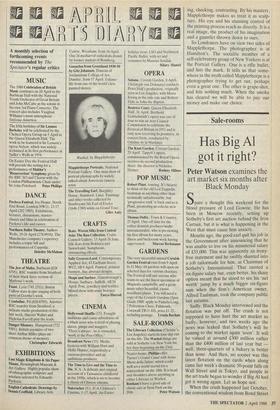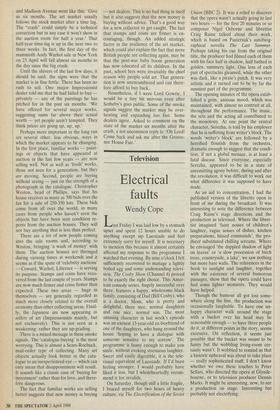Sale-rooms
Has Big Al got it right?
Peter Watson examines the art market six months after Black Monday
Spare a thought this weekend for the blood pressure of Lord Gowrie. He has been in Moscow recently, setting up Sotheby's first art auction behind the Iron Curtain, but it is what is happening in the West that must cause him anxiety.
Months ago, the good earl quit his job in the Government after announcing that he was unable to live on his ministerial salary of £33,000. This was apparently an irony- free statement and he swiftly shunted into a job tailormade for him, as Chairman of Sotheby's International. That carried a six-figure salary but, even better, his share option meant that he stood to see his 'net worth' jump by a much bigger six-figure sum when the firm's American owner, Alfred. Taubman, took the company public last autumn.
Sadly, Black Monday intervened and the flotation was put off. The crash is not supposed to have hurt the art market so badly, however, and two weeks ago the news was leaked that Sotheby's will be coming to the market again 'soon'. It will be valued at around £300 million rather than the £400 million of last year but well, three-quarters of a bakery is better than none. And then, no sooner was this latest flotation on the cards when along came last week's dramatic 50-point falls on Wall Street and in Tokyo, and people in the art trade began to wonder if Big Al had got it wrong again. Let us hope not.
When the crash happened last October, the conventional wisdom from Bond Street and Madison Avenue went like this: 'Give us six months. The art market usually follows the stock market after a time lag. The "crash" could simply be a technical correction but in any case it won't show in the auction room for half a year.' That half-year time-lag is up in the next two to three weeks. In fact, the first day of the mammoth Andy Warhol sale in New York on 23 April will fall almost six months to the day since the big crash.
Until the shivers of the last few days, it should be said, the signs were that the market is in fine fettle. There has been no rush to sell. One major Impressionist dealer told me that he had failed to buy privately — any of the paintings he has pitched for in the past six months. 'We have offered for several major works, suggesting sums far above their actual worth — yet people aren't tempted. They think prices are going up, up, up.'
Perhaps more important in the long run are several other, less obvious, ways in which the market appears to be changing. In the first place, familiar works — paint- ings or objects that have appeared at auction in the last few years — are now selling well. Not as well as 'fresh' works, those not seen for a generation, but they are moving. Second, people are buying without seeing — just on the strength of a photograph in the catalogue. Christopher Weston, head of Phillips, says that his house receives as many as 700 bids over the fax for a sale of 250-350 lots. These bids come from all over the world, in many cases from people who haven't seen the objects but have been sent condition re- ports from the auction houses. They will not buy anything that is less than perfect.
There are a lot of new people coming into the sale rooms and, according to Weston, bringing 'a wash of money' with them. The auction houses are thronged during viewing times at weekends and it seems as if the spate of 'celebrity auctions' — Coward, Warhol, Liberace — is serving its purpose. Stamps and coins have reco- vered from the last couple of years. Stamps are now much firmer and coins firmer than expected. These two areas — huge in themselves — are generally regarded as much more closely related• to the overall economy than other collecting areas. Final- ly, the Japanese are now appearing as sellers of art (Impressionists mainly, but not exclusively). This is not seen as a weakening: rather they are up-grading.
There is a mixed message in these smoke signals. The 'catalogue-buying' is the most worrying. This is almost a Sears-Roebuck, mail-order type of collecting. Many art objects actually look better in the cata- logue to an inexperienced eye — which can only mean that disappointment will result. It sounds like a classic case of 'buying for investment' rather than for love, and there- fore dangerous.
The fact that familiar works are selling better suggests that new money is buying — not dealers. This is no bad thing in itself but it also suggests that the new money is buying without advice. That's a good way for a new collector to get caught. The fact that stamps and coins are firmer is en- couraging, though. An added strategic factor in the resilience of the art market, which could also explain the fact that more British people are collecting again, may be that the post-war baby boom generation has now educated all its children. In the past, school fees were invariably the chief reason why people sold art. That genera- tion is now unencumbered and can there- fore afford to buy back.
Nonetheless, if I were Lord Gowrie, I would be a tiny bit nervous even after Sotheby's goes public. Some of the smoke signals suggest the market may be over- heating and expanding too fast. Some dealers agree. Asked to comment on the state of the market six months after the crash, a not uncommon reply is: 'Oh Lord! Come back and ask me after the Grosve- nor House Fair.'



















































 Previous page
Previous page